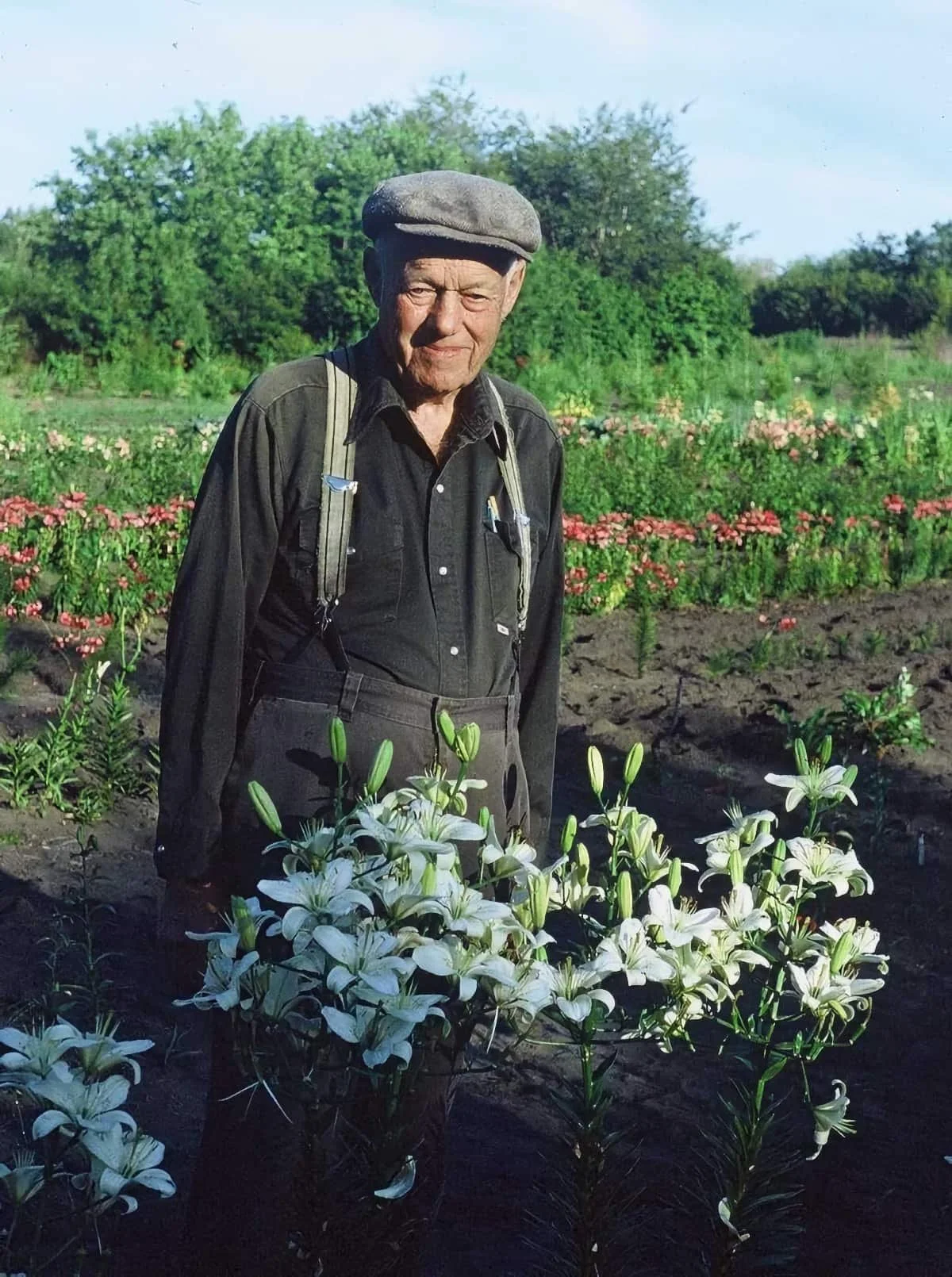Saskatchewan Perennial Society: Bert Porter, lily breeder par excellence
By Sara Williams
Working alone and in geographic isolation, Bert Porter had neither formal horticultural education nor public or institutional support. Yet he made major contributions to prairie fruit breeding, developing strawberries and raspberries that combined the hardiness of the native fruit he had picked as a child with the quality of tender varieties that wouldn’t stand a chance on the Canadian prairies. In lily breeding, he took up from where Cecil Patterson and others had left off, selecting for better form, purer colours, fragrance, earlier and later flowering, and dwarfness.
Bert Porter with his lily 'Happy Thoughts'. Photo Credit: Sara Williams
But if you’ve ever tasted ‘HoneyRed’ rhubarb or ‘Honeywood’ saskatoons, or grown the lovely, white flowering, fruitless ‘Spring Snow’ crabapple, you’ve benefited from Bert Porter’s plant breeding. And then there are his amazing lilies, among them:
‘Earlibird’ (1956) – outfacing, clear vivid apricot, early, 80 cm (30 inches), resistant to botrytis, durable garden lily
‘Pink Champagne’ (1963) – out and down-facing, yellow with pink overlay, late July and August, 120 cm (48 inches).
‘Flaming Giant’ (1975) – up-facing, large, cup-shaped flared blooms, vivid red-orange, spots, July, 120-150 cm (48-60 inches), good substance.
‘Geisha Girl’ (1975) – out and down-facing, lemon yellow with spots, July, 80 cm (30 inches).
‘Cinnamon Toast’ (1984) – up-facing, clear white with cinnamon spots, July, 90 cm (36 inches).
‘Golden Age’ (1984) – up-facing, golden yellow, July-August, 75-90 cm (30-36 inches).
‘Happy Thoughts’ (1986) – up-facing, pure white, almost spotless, hint of green in throat, ivory stripe along mid-rib of each petal, candelabra type of flower, July, 75-100 cm (30-40 inches).
Born in 1901 in Guilford in Surrey, England, he came to Canada in 1907 with his mother and two younger siblings to join his father who had begun homesteading the previous year near Parkside, Saskatchewan. His father, a lay preacher, looked after the community’s spiritual needs, while his mother served as a nurse.
In 1919, Bert attended Normal School in Saskatoon for a six-week teacher training course and then taught at several rural schools over the next 12 years.
Gentle and somewhat shy, Bert was by nature sympathetic to children and took to his chosen profession. But with the Depression under way, positions became more difficult to obtain. He recalled applying for a job in the early 1930s. “I answered an ad for a teaching position. I got a nice reply thanking me and indicating that I was well qualified. But they said that they wanted a lady teacher as there were so many bachelors in the district, including the members of the school board.”
By 1934, Porter had returned to Parkside and begun Honeywood Nursery. It was predominantly mail order. He recognized there was a need for hardy fruit on the prairies and so grew strawberries, raspberries, apples and plums, concentrating on hardiness, fruit quality and productivity. Over the next fifty years, Porter was to breed, select and introduce many fruit varieties.
In the spring and fall he sold raspberry and strawberry plants. He soon began growing, breeding and selling lilies. During the two weeks of prime lily season, he complained that he was able to get little work done because of the large number of people who came to view his fields of lilies in bloom. But he was always a gracious and humble host!!
Alan Daku, a horticulture graduate from the University of Saskatchewan, joined Porter in July of 1978 and became a partner in 1980. By the mid-1980s, under Daku’s influence, Honeywood expanded into perennial production.
In 1983 Bert was awarded an Honorary Doctor of Law degree from the University of Saskatchewan in recognition of his work in horticulture. He continued to work at the nursery until 1991, when he and his wife, Winnie, moved to seniors housing in Parkside. He died in 2000 and is buried in Honeywood Cemetery. He is remembered as a kind, quiet, unassuming, tolerant and humble person with a love and total devotion to plants.
In the fall of 1999, a group of 16 long-term community members purchased the nursery to save Bert Porter’s legacy. The old log home became an interpretive centre and tearoom. Honeywood is open to the public through the summer and early fall and is home to fields of lilies, fruit trees, peonies, daylilies, roses and a collection of speciality trees and shrubs (many of which are for sale), as well as a unique gift shop. Lilies in Bloom, to which the public is welcome, is held on a Sunday during the third week of July.
In 2001, Honeywood was designated a Municipal Heritage Property and in 2007 a Provincial Heritage Property.

